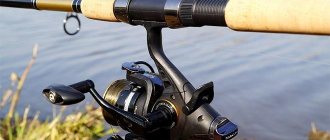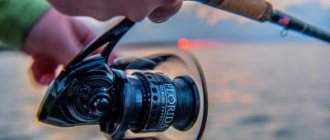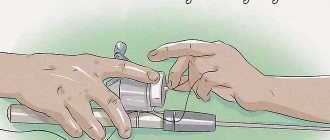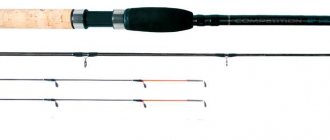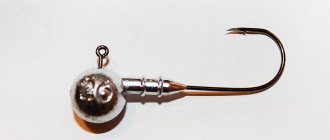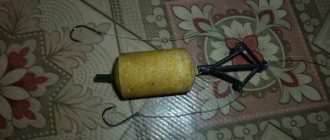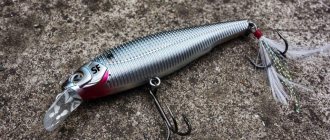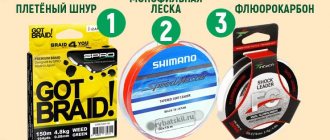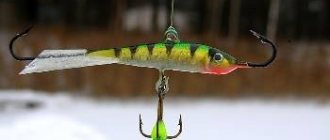Modern spinning reels usually have two types of friction brake: rear and front.
Both the first and second are quite important elements of the reel, as they are actively used in different types of fishing. And although their main function is essentially the same, the rear and front friction brakes differ from each other not only in location, but also in the internal structure of the mechanism, as well as in terms of convenience when used in various conditions and situations.
Front clutch

The front friction brake is more relevant specifically for spinning fishing, especially when using light and ultralight gear.
The front drag is more sensitive, while the rear drag can in some cases be ineffective if set too finely, and subsequently miss sharp jerks from relatively small fish.
However, at the same time, the front clutch also has a significant drawback: it is inconvenient to adjust at the stage of fishing for a potential catch. At such moments, the rear clutch is much more convenient.
The front friction brake is considered to be more reliable due to its simple design.
Very important advice: when transporting and storing the reel, unscrew the clutch to maximum softness. This will extend its service life!!!
Classification
Let's consider the location of the clutch on the reel and what such a device gives to the angler.
There are spinning reels with front and rear friction brakes. If the former, as a rule, are used for spinning fishing, then the latter are used for feeder rods. There is also a system that combines these two brakes. She's called a Bayrunner.
Each of the systems has the right to life and has its own positive and negative features.
The front friction brake is more sensitive than the rear.
Therefore, it is most often used for ultralight fishing:
- The adjustment is made using a special screw that secures the spool. Because of this, you have to spend a significant amount of time changing it.
- It is believed that reels with a front brake are more reliable, as they are equipped with a mechanical circuit.
- In such reels, winding can be adjusted by placing washers under the spool.
Reels with a rear-mounted friction brake differ from the previous ones in a number of parameters:
- Allows you to adjust the tackle even while fishing.
- The spool can be changed with a simple press.
- The cost of the spool is much lower.
- The clamp washer and nut are missing. When changing spools there is a risk of losing them.
The baitrunner allows you to dampen sudden jerks of the fish before hooking. After hooking, you need to switch to the front clutch.
- Such coils, together with a marker float, can be used to check the depth of a reservoir.
- Prevents the rod from falling into the water from the stand.
- The mechanism itself, due to more precise balancing, is less susceptible to vibration and operates more smoothly.
The purpose of a single rear and front clutch is to land fish after hooking. In the case of using a baitrunner, the purpose of the front clutch is fishing, and the rear clutch is to adjust the force of free rotation of the spool before hooking.
Today, models with three clutches have appeared on the fishing reel market.
- The third “fighting brake” is designed for landing large fish.
- Each of the three brakes has a different ratchet sound. Thus, it is easier for the fisherman to determine which of the clutches is working at the moment.
The prices for such reels are quite high. Before buying one, you should think about its feasibility.
Rear clutch

Second, the rear drag is used primarily in feeder or trolling fishing.
It has less sensitivity compared to the front one, but when catching large fish with heavier, more powerful gear, a high level of sensitivity is by and large not needed.
The rear drag is less sensitive but more convenient due to its location at the rear of the reel!!!
Types of clutches
Despite the various types of fishing reels, spinning reels have only two types of friction mechanisms:
- front;
- rear.
The front clutch is located on the spool. This option is more popular and in demand among spinners because it has the following advantages:
- Less inertia-free weight, which has a positive effect on the balance of the assembled tackle;
- Simplicity and reliability of the design, which implies the durability of this unit;
- Generally better sensitivity and fine adjustment.
Spinning reels with a front clutch are not without their disadvantages:
- A spare spool for such a spinning spool is more expensive due to the direct location of the mechanism on it;
- Most spinning anglers find it inconvenient to adjust the brake when retrieving a predator;
- It is more difficult to replace the spool;
- Dirt and suspended matter may get in, which will cause malfunctions.
Advice! When servicing the inertia-free brake at the end of the season, the dirty brake must be thoroughly cleaned. It uses only specialized lubricant for the reel clutch.
The rear clutch is located at the rear of the reel, immediately behind its main unit - the main pair. This arrangement is typical primarily for feeder or match fishing reels. It is rarely used in spinning today, mainly on budget products from Chinese manufacturers.
Reels with rear drag have the following advantages:
- It is convenient to adjust the trigger load during fishing;
- Due to the absence of unnecessary elements, a spare spool is cheaper and easier to replace;
- It works better on heavy gear with equipment and lures of impressive weight.
Rear drag >spinning reels are heavier, which can affect the balance of the set. They are not so sensitive, which is why all ultralight spinning reels are fishing reels with a drag located in the front.
There are also reels in which the rear and front brakes are connected into one system. These are inertia-free games with a batrunner. There is an option to combine the rear location of the main and auxiliary brakes. Their essence lies in the fact that the clutch is adjusted quite roughly, close to the maximum loads, and the fightrunner is obviously weakened. As a result, during sharp jerks of large fish, if the front mechanism does not have time to work, the rear mechanism repels the sudden throw of the trophy, preventing the equipment from breaking.
Important! The baitrunner is used primarily in carp fishing. By leaving the reel with the mechanism turned on, you don’t have to worry that when a carp or carp bites, it will drag the gear into the water.
The best fishing reels are developed and produced by two Japanese companies, whose names are known to fishermen from all over the world. This is Shimano and Daiva. They constantly compete with each other for the title of the best brand, regularly invent various innovations, in particular, modernize the friction mechanism.
Friction Brake Setting
At first glance, there are no difficulties in adjusting the clutch. You just need to adjust the brake so that it reacts to strong resistance from the fish or a serious hook, and subsequently releases a certain amount of fishing line.
However, remember that to activate the friction brake when tensioning the line passed through all the rings, you need to apply more force than when the line is pulled directly from the reel, without passing through the rod rings. That is, for optimal adjustment of the clutch, it is necessary that the fishing line has already been passed through all the rings of the spinning rod.
What are they like?
Inertia-free reels with rear drag are most often used for float fishing. The point is not only that when fishing with a float, the weight of the catch is not so significant. Often on such fishing we come across roaches or bream weighing up to half a kilogram. Another advantage is that to catch small fish there is no need to equip the reel with powerful brakes, which naturally makes it heavier. Spending a full day on the river holding a fishing rod and a heavy reel in your hand is not the best option.
The rear brake, due to its significantly smaller size, also has less weight. The diameter of the brake washers is also smaller, so they are not designed for high breaking forces and line bleeding forces. Due to the same factor, it seems possible to more accurately adjust the braking forces on thin fishing lines, which are most often used in float fishing.
Since the spool does not have a front brake, changing the spool is very quick. You need to unscrew the brake nut that secures the spool to the reel. By pressing a button, the spool is removed and replaced with another one, for example, with a thinner line. A reel with a rear drag usually comes with two spools. The main one is made of light metal, and the second spare one is made of plastic or graphite. There are reels with rear drag, which can have 3 or 4 spools in the set.
Inertia-free reels with a rear brake are equipped with ball bearings in all critical components. Modern inertia-free reels with rear drag have from 4 to 10 ball bearings, which greatly facilitates their movement and extends their service life.
Clutch adjustment method
So, you can try to adjust the clutch in the following way: tie the end of the fishing line to some object, and then gradually pull the rod at an obtuse angle up to 120 degrees and set the clutch to operate at 70-75% of the load (at a load of 100%, the fishing line naturally breaks).
Thus, on the one hand, you eliminate the possibility of unwanted loss of excess line at the fishing stage, and on the other hand, you provide the fish with good resistance without the threat of the tackle breaking.
If you think that the hooked fish has very soft lips, the clutch needs to be loosened even more, this will reduce the chance of the fish leaving.
Author of the article: Vitaly Leonidovich Ivanov, 2021.
Only February 23rd - 23% discount when purchasing in a retail store!!!
In this section you can choose and buy a Mifine reel .
Mifine fishing reels belong to the budget price segment. Despite this, they are in deserved demand both among novice amateur fishermen and among experienced fishermen seeking to expand their stock of reliable fishing reels “for all occasions.”
Modern Mifine reels come in a wide variety of types and sizes, which allows you to choose the most optimal model for use in certain fishing conditions.
One of the most popular sizes is the Mifine 3000 reel . In fact, this is the most popular and sought-after spool size, which not only provides impressive line capacity, but also ensures a high casting range and quite powerful traction, which is enough even to fish out a very large predator or peaceful fish . Reels with this spool size have a fairly low weight combined with excellent performance characteristics, which allows them to be used in both spinning, feeder and carp fishing.
The next series in terms of power and size is the Mifine 4000 coil . This is a more serious and very powerful reel. Their main area of application is powerful spinning rods, feeder and carp fishing rods. The large size of the spool allows long-distance casting of heavy baits or feeders, which is especially important when fishing with a feeder or carp fishing rod. They can also be installed on sea fishing rods for surf casting - sea fishing from the shore.
The most powerful model is the Mifine 6000 reel . This is truly a full-fledged heavyweight among spinning reels. They have an extremely impressive spool line capacity, which, with certain skills, makes it possible to cast at distances of over 150 meters. The 6000 spool size means that the reel has excellent thrust readings, which allows you to land very large and truly trophy specimens. Such reels are used exclusively in conjunction with carp or sea fishing rods. This is due to the fact that all models have a rather impressive weight, which makes it impossible to effectively balance more delicate and lighter feeder or spinning rods.
The Mifine multiplier reel also deserves special attention . This is a completely separate type of reel that can only be used with special spinning rods. Multipliers are usually used for sea trolling fishing. In freshwater fishing, they can also be used for trolling, as well as for fishing with jerkbaits - large and heavy baits that require a powerful and strong rod and a high-torque, reliable reel. The key feature of this type of coil is the principle of its operation. In fact, this is a compact hand winch without additional gears and transmission mechanisms. This determines such qualities of multiplier reels as reliability, durability, the highest level of traction and ease of maintenance.
The Mifine spinning reel is an inexpensive and reliable tool for every angler. They optimally combine high quality and amazing reliability and a low price, which makes their purchase accessible to every angler. Buying a reel with a reel means purchasing a reel with high performance characteristics and excellent workmanship, which is considered the prerogative of reels in a higher price segment.
Types of friction brakes
The essence of the clutch action is that it is adjusted to a given force using a special regulator. For example, if the thread can withstand 8 kilograms, then the brake is set to 5-6 kg. When the hooked fish makes a sharp jerk that exceeds the breaking capacity of the line, it will remain intact.
In this case, the scaffolding will begin to peel away under the influence of the load, as the friction brake will operate. That is why there should be a significant supply of monofilament or braid on the spool, so that when catching a catfish you will not regret the saved meters. You can read about the methods in the article “Fishing with a spinning reel depending on the conditions and fishing method.”
Depending on their location on the inertia-free clutch body, clutches can be designed in the following options:
- Front location
. This location of the adjusting screw and brake is considered classic, while the entire structure is made on a spool. When the spool is replaced, the brake mechanism also changes. Such inertia-free forks are considered to be high-speed, since they are designed for the use of scaffolding with a small cross-section and light load. This type of friction brake is very finely adjusted; per click the force changes by 200-300 g. - Rear location
. The adjustment screw is located in the back of the case, which is considered much more convenient, since it does not interfere with the wood. But this type takes place in power meat grinders, whose purpose is feeder, trolling, carp phishing. The adjuster pitch on rear-wheel drive clutches is approximately 500 grams. If you use a thread with a small cross-section, then with one mark of the adjustment knob it will come off quite easily; when tightened by one click, the force for it will become critical.
The brake of a spinning reel is more comfortable, the greater the number of parts on which the load falls are in contact with each other. In the rear-wheel drive clutch, the emphasis is on Teflon washers, in the front-wheel drive - thanks to the entire surface area.
If the reverse brake on a spinning reel has disappeared, this indicates that it has not been properly maintained and water has penetrated inside the housing or the lubricant has simply thickened. There are, of course, other reasons that require the intervention of a specialist, but in the event of a blockage, it is enough to carry out maintenance yourself.
